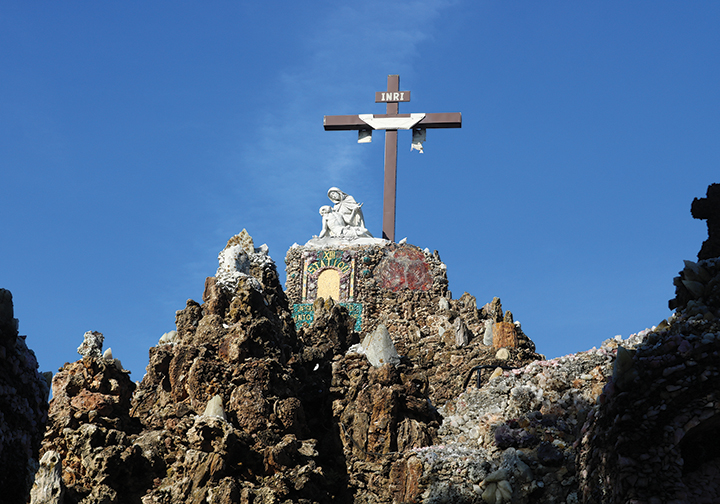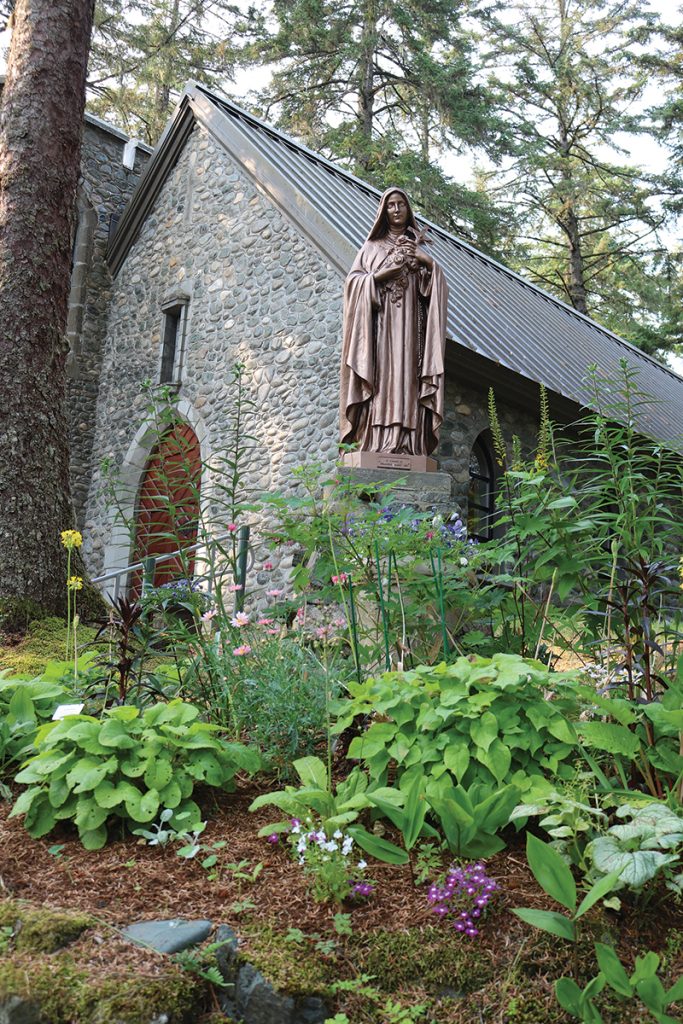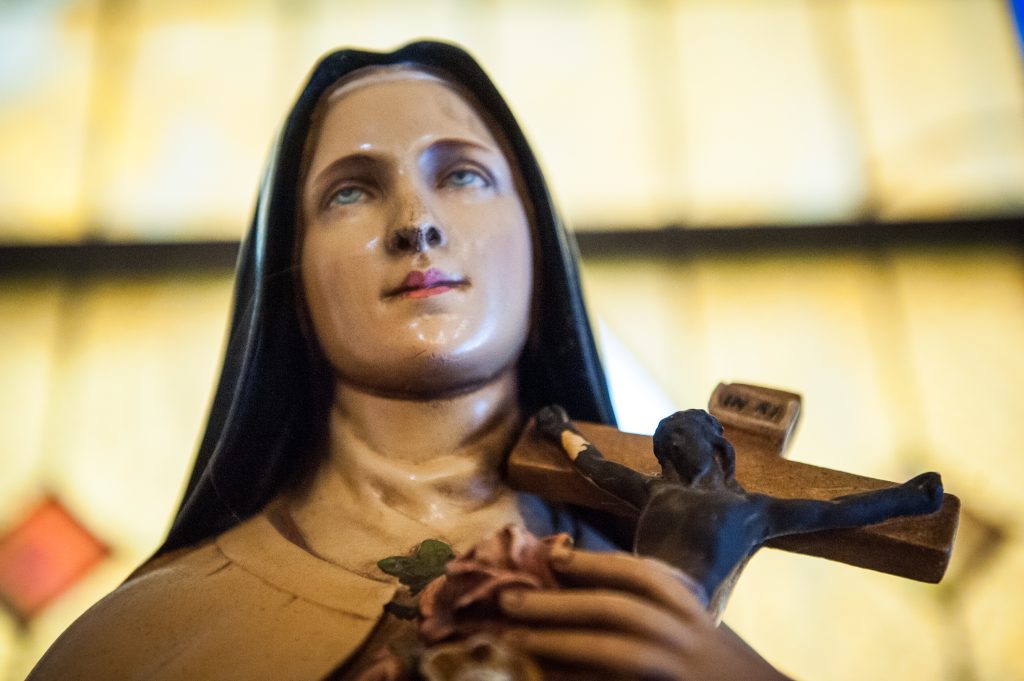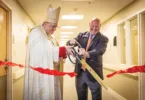
by Marc and Julie Anderson
mjanderson@theleaven.org
It’s nearly that time of year — time for summer vacation.
While it’s important to recharge physically, it’s also important to renew yourself spiritually. The benefits, experts say, are endless.
Rita McIntyre, director of music ministries at the National Shrine of the Cross in the Woods, located in Indian River, Michigan, said shrines are the perfect solution.
“When we make pilgrimage to any shrine — and Cross in the Woods is certainly no exception — we want to have an encounter with the living God. Shrines display God’s presence through the Word, the sacraments and art. The benefits are whatever gifts we are willing to accept from God in our encounter with him.”
“Many people who visit Cross in the Woods, either for holy Mass, Liturgy of the Hours or just to stroll around the property,” she continued, “express feelings of being at peace, being relieved of spiritual burdens, as well as feeling a sense of awe in regard to the beauty of creation.”
So, why not consider a pilgrimage — and start your planning now?
Research places of pilgrimage.
First, you will find shrines everywhere. A trip to Hawaii can include the opportunity to pray at a saint’s final resting place. Or, a vacation to Colorado could provide your family the opportunity to rejuvenate in the mountains, walking on a stairway to prayer. The possibilities are endless, but a little planning goes a long way.

Call or email ahead of time.
Even if you spend time researching a shrine, experts say it’s always a good idea to call the shrine or email prior to your visit. Many shrines operate with small staffs and/or with the help of volunteers who work other full-time jobs. As a result, sometimes websites may not get updated with the latest information in terms of operating hours and/or special events.
For example, the National Shrine of St. Thérèse about 22 miles north of downtown Juneau, Alaska, is operated by only two staff members, Joe Sehnert and his wife Colleen, who serve as the executive director and caretaker, respectively.

The shrine’s volunteers perform a variety of functions from driving pilgrims from the cruise ship docks to the shrine, to maintaining the extensive gardens of plants, all of which are mentioned in sacred Scripture. Mass is usually offered only on Sundays, but if you’re lucky, you might get to spend time at the shrine during a week when a priest is on site.
Ask about some of the shrine’s hidden gems pilgrims sometimes miss.
Some shrines are small, but some are extensive. It can be easy to overlook some of a shrine’s features. Experts say it’s important to ask questions so you don’t miss anything.
For example, Maria Stein Shrine of the Holy Relics has the nation’s second largest collections of first-class relics, more than 1,200. If you just walk in, look around quickly and then leave the chapel, you can definitely miss something.
“I think people can miss the fact that we have a lot of relics from Christ’s life,” Matthew Hess, director of ministry and hospitality, said, adding the collection includes what they believe to be relics of the true cross, a small piece of the veil Veronica used to wipe Jesus’ face as he walked to Calvary, a small piece of the table used for the Last Supper, a piece of the crib from Bethlehem and a thorn from the crown Christ wore during his scourging and passion.
Unlike Maria Stein Shrine of the Holy Relics, the gems are not so hidden at the Grotto of the Redemption in West Bend, Iowa.
The largest man-made grotto in the world, the shrine’s series of nine grottoes contain more than 250,000 semiprecious stones and more than 250 different kinds of rocks. The dream of Father Paul Dobberstein, the grotto contains everything from geodes to pearls and was built with more than 100 train- car loads of materials.

According to Andy Milam, director of marketing, walking through the grotto affords pilgrims an opportunity to see a “myriad of rocks that you normally wouldn’t see.”
Additionally, the shrine has 59 museum-quality statues made of Carrara marble.
“Finding the hidden treasures is about going and finding that one statue or going and finding the one rock or going and finding that one kind of rock,” Milam said. “Rocks are part of God’s creation, and he [Father Dobberstein] chose that medium in which to express himself.”
After tours, Milam encourages pilgrims to lose themselves somewhere in the grotto.
“When you’re lost in it, when you allow yourself to be overcome by it, you can find yourself,” he said.
Consider a different parish or a nearby shrine.
Sometimes flying somewhere or taking a long road trip isn’t feasible. Consider going to a nearby parish, preferably one you haven’t visited previously. The archdiocese itself has nearly 100 different parishes within its boundaries.
Hess, who sometimes explores nearby churches in his home state, agreed.
“It’s good to get away, to experience something new,” he said. “We always say the outward journey and the outward transformation of leaving home and going to a holy place and coming back mirrors an inward journey.
“When someone comes to a shrine, they should come back different than when they left [home]. They’re spiritually refreshed or maybe have new insight. It gives you a different perspective.”
“It gets you out of the ordinary and the mundane, ready to encounter something new,” he added.
Set aside enough time.
Making a pilgrimage, experts say, is about taking time for spiritual renewal by making a journey, sacrificing time and money that could be spent elsewhere to arrive at a different place spiritually than before you arrived.
“When you go on a pilgrimage, it’s good not to put a time frame around it,” Sehnert said. “It would be really good to let the Spirit move you. . . . So many people don’t even know the shrine is here, but when they finally get to it, they say, ‘Oh gosh, I wish we had more time to spend here.’”
Make time for a pilgrimage
by Marc Anderson
Special to The Leaven
With blue eyes, fair skin and a Swedish last name, most people don’t realize I’m also Native American.
Three years ago, I went through a naming ceremony during which I received the name “Padebwayadzet,” a name selected by the elders of the Citizen Potawatomi Nation. It translates into “going about living a life of faith.”
During the ceremony, I recalled another special time in my life.
In 2012, Blessed Kateri Tekakwitha, the “Lily of the Mohawks,” became the first Native American to be canonized. I wanted to attend the canonization in Rome, but it wasn’t feasible. Instead, we drove 19 hours from Topeka to Fonda, New York, the saint’s home village, to participate in the celebration there.
I wish I could say I remember every detail, but I was awestruck. Even though we weren’t at the canonization, we were celebrating with other pilgrims in St. Kateri’s hometown!

The next day, we realized our hotel was about an hour from Stockbridge, Massachusetts, home of the National Shrine of Divine Mercy. Just 12 years earlier, St. Pope John Paul II had declared the Sunday after Easter to be celebrated as Divine Mercy Sunday. In fact, our first assignment for The Leaven was to cover a celebration of Divine Mercy at Most Pure Heart of Mary Church in Topeka. So, off we went.
While there, we learned the church had approved an optional memorial beginning that very day, Oct. 22, the 34th anniversary of the inauguration of St. John Paul’s pontificate. And, of course, the shrine was going to celebrate that memorial. Again, God’s kindness blessed us in a way we didn’t expect.
So, my advice to others is simple: Make the time for a pilgrimage.
Be open to God’s grace and blessings
By Julie Anderson
Special to The Leaven
Be open to the graces and blessings God wants to pour out upon you.
That’s the tip I’d offer anyone making a pilgrimage to any sacred place. It comes after years of making pilgrimages to churches, cathedrals and shrines from Alaska to Florida, California to New York.
In 2000, the day following our first Leaven assignment, Marc and I left for Wisconsin. On the way, we made the first of numerous pilgrimages to the National Shrine of St. Thérèse in Darien, Illinois, headquarters of the Society of the Little Flower.

The shrine features the largest collection of the saint’s relics outside her native France, and it’s definitely worth the time. But in 2018, I encountered St. Thérèse unexpectedly in Hubertus, Wisconsin, just outside Milwaukee.
Two days earlier, I had searched online for the Mass schedule at Holy Hill Basilica and National Shrine of Mary, Help of Christians, and learned the shrine was hosting an exhibit of photos of St. Thérèse. Of course, I had to go.
Once there, we headed directly to the exhibit. Then I spotted a sign indicating confessions were being heard. We quickly got in line.
I still remember going into the confessional, crying tears of joy, as I told the priest how meaningful it was to be able to receive the sacrament in a chapel dedicated to St. Thérèse on my wedding anniversary. And while I don’t recall his exact words, I remember the priest was touched, too.
I could write volumes about our many pilgrimages, but I’ll just repeat what I said earlier: Be open to the graces God wants to give you. He can never be outdone in generosity.






